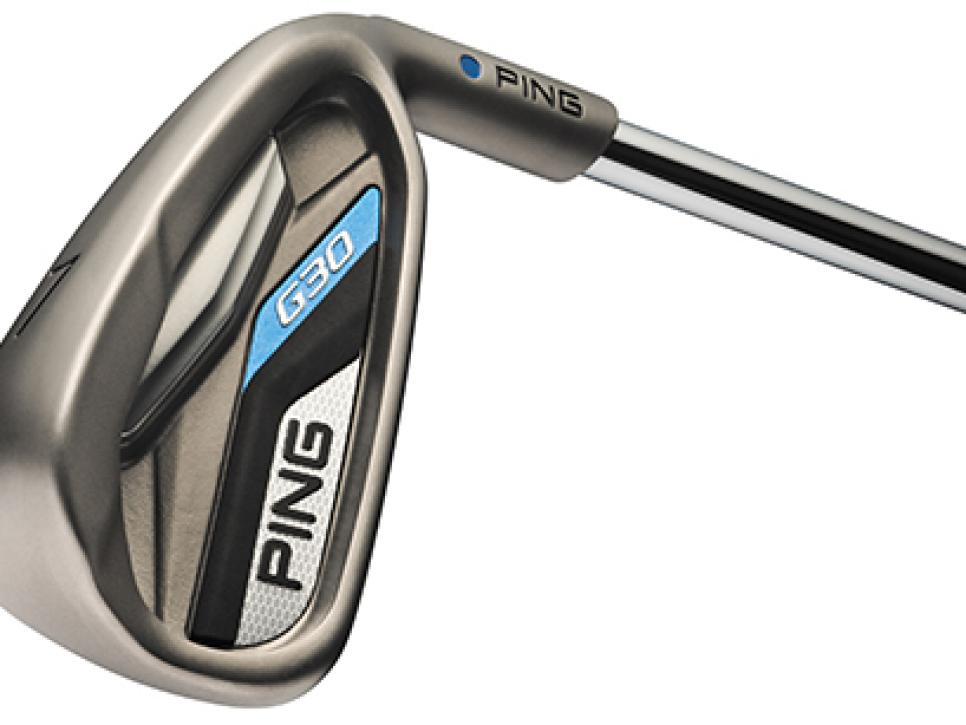News
Ping G30 iron blends Karsten, i25 irons

There's no question the Ping G-series irons have been the workhorse of the Ping iron family since they were first introduced in 2003. Their main mission statement has been about forgiveness, but in the latest iteration, the G30, the goal has been to provide that kind of forgiveness within a shape that does not get too extreme.
The answer for Ping engineers came by borrowing ideas from two of its current irons, the i25 and the Karsten. While the Karsten is more toward the forgiveness end of the spectrum and the i25 is more geared to better players, each has attributes that work in the G30 chassis, says Ping senior design engineer Marty Jertson. "What we were trying to do is get as much distance and height as we could but do it in a package that's not as jumbo as the Karsten," Jertson said. "We took some stuff from the Karsten in terms of a balanced approach to distance and gapping and getting more height and stopping power, and then we added some of our learning from the i25 and matched a lot of the sole contours and the bounce profiles."
This latter element is a key performance benefit, not a cosmetic question, says Jertson. "We've got just the right contour on the lead edge radius to prevent the initial dig into the ground, and then plenty of angle and camber to keep the club moving forward instead of going downward. If you impact the big ball before the little ball, it still sends the club forward instead of it going down too much."
That's not something that's easily modeled on computers, either. "We've done a little bit of work in modeling the turf in FEA [finite element analysis], but we're kind of on the front end of that," Jertson says. "But turf interaction is a big part of the forgiveness of an iron. It's what makes it different and more challenging than a driver. That's why we really have to do more player testing. You can't rely on robots because a robot doesn't include the ground impact influence on the forgiveness of the iron. The fact is you can have a super forgiving iron design, but if you have a sharp leading edge it won't play forgiving."
Of course the other part of forgiveness comes from increasing an iron's potential for distance and decreasing the negative effects of off-center impacts. The G30 continues the search for ball speed by thinning the face on the 4- through 7-irons, which feature slightly longer blade lengths for increased stability. The company's trademark "custom tuning port" in the back cavity is positioned lower to help increase launch angle.
"With the modern day golf ball and the way it flies through the air, we need to focus on ballspeed," Jertson says. "And again, with the current ball, ballspeed is pretty big driver of how high the ball will fly, too. It's a large lever of getting more maximum height and a large lever of getting more stopping power."
The effort with G30, Jertson says, is to take "a more calculated approach to strengthen the lofts and the lengths and to get more face bending in those long irons at impact."
Conversely, he says, engineers take a different approach in the shorter irons "to focus more on consistency and control and lowering launch and increasing the spin slightly."
The result is staggered changes through the set (the 4-, 5- and 6-irons are 2 degrees stronger than the G25, the 7-iron is 1.5 degrees stronger, the 8-iron is a degree stronger and the rest of the set's lofts match the G25).
Jertson says another part of tweaking the design of each iron in the set lies in the area of feel. "If you have a club where the ball speed is hot, but it doesn't have the feel to match it, that's not a good solution for the golfer," he says. "And when we get a little thicker in the face in the short irons, it gets us a little softer, quieter feel as well as move the center of gravity more forward and stabilize the face."
Cast from 17-4 stainless steel, the G30 is available in 4-iron through pitching wedge, as well as UW (50 degrees), SW (54 degrees) and LW (58 degrees). The offset progresses from .29 inches in the 4-iron to .08 inches in the LW. The G30 ($100 per club) is available for pre-order now.